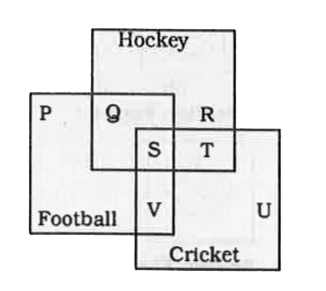The following questions are based on the information given below:
Out of a group of 60 students, 25 play Cricket, 30 play Football, 24 play Volleyball, 10 play Cricket and Football, 9 play Cricket and Volleyball, 12 play Volleyball and Football and 5 play all the three.
How many students play Cricket only?
A. 11
B. 13
C. 8
D. 5
D
C
A
B
The correct Answer is:C
To find out how many students play Cricket only, we can use the principle of inclusion-exclusion and Venn diagrams. Let's break down the problem step by step.
Step 1: Define the sets
Let:
- C = number of students who play Cricket = 25
- F = number of students who play Football = 30
- V = number of students who play Volleyball = 24
Step 2: Define the intersections
We also know:
- C∩F = number of students who play both Cricket and Football = 10
- C∩V = number of students who play both Cricket and Volleyball = 9
- F∩V = number of students who play both Football and Volleyball = 12
- C∩F∩V = number of students who play all three sports = 5
Step 3: Calculate the number of students playing only two sports
Now, we can find the number of students who play only two sports:
- Students who play Football and Volleyball but not Cricket:
(F∩V)−(C∩F∩V)=12−5=7
- Students who play Cricket and Football but not Volleyball:
(C∩F)−(C∩F∩V)=10−5=5
- Students who play Cricket and Volleyball but not Football:
(C∩V)−(C∩F∩V)=9−5=4
Step 4: Calculate the total number of students playing Cricket
Now, we can calculate the total number of students who play Cricket:
- Students who play only Cricket:
Let x be the number of students who play only Cricket.
The total number of students who play Cricket can be expressed as:
x+(C∩F∩V)+(C∩F)−(C∩F∩V)+(C∩V)−(C∩F∩V)=C
Substituting the known values:
x+5+5+4=25
Simplifying gives:
x+14=25
Therefore:
x=25−14=11
Conclusion
The number of students who play Cricket only is 11.
Let:
- C = number of students who play Cricket = 25
- F = number of students who play Football = 30
- V = number of students who play Volleyball = 24
We also know:
- C∩F = number of students who play both Cricket and Football = 10
- C∩V = number of students who play both Cricket and Volleyball = 9
- F∩V = number of students who play both Football and Volleyball = 12
- C∩F∩V = number of students who play all three sports = 5
Now, we can find the number of students who play only two sports:
- Students who play Football and Volleyball but not Cricket:
(F∩V)−(C∩F∩V)=12−5=7
- Students who play Cricket and Football but not Volleyball:
(C∩F)−(C∩F∩V)=10−5=5
- Students who play Cricket and Volleyball but not Football:
(C∩V)−(C∩F∩V)=9−5=4
Now, we can calculate the total number of students who play Cricket:
- Students who play only Cricket:
Let x be the number of students who play only Cricket.
The total number of students who play Cricket can be expressed as:
x+(C∩F∩V)+(C∩F)−(C∩F∩V)+(C∩V)−(C∩F∩V)=C
Substituting the known values:
x+5+5+4=25
Simplifying gives:
x+14=25
Therefore:
x=25−14=11
The number of students who play Cricket only is 11.
Similar Questions
In a group of 100 children, 32% play hoceky, 64% play football and 40% play cricket. 14% play hockey and football , 155 play football and cricket , 13% play hockey and cricket. Only 6% play all the three games .
(a) How many children play one game ?
(b) How many children play atleast two game ?
(c) How many children play hockey or football but not circket ?
View SolutionIn a group of 100 children, 32% play hoceky, 64% play football and 40% play cricket. 14% play hockey and football , 155 play football and cricket , 13% play hockey and cricket. Only 6% play all the three games .
(a) How many children play one game ?
(b) How many children play atleast two game ?
(c) How many children play hockey or football but not circket ?
View Solution
Knowledge Check
The following questions are based on the information given below:
Out of a group of 60 students, 25 play Cricket, 30 play Football, 24 play Volleyball, 10 play Cricket and Football, 9 play Cricket and Volleyball, 12 play Volleyball and Football and 5 play all the three.
How many students play exactly two games?
A. 7
B. 13
C. 5
D. 16ADBBCCDAThe following questions are based on the information given below:
Out of a group of 60 students, 25 play Cricket, 30 play Football, 24 play Volleyball, 10 play Cricket and Football, 9 play Cricket and Volleyball, 12 play Volleyball and Football and 5 play all the three.
How many students do not play any one of the games?
A. 5
B. 2
C. 7
D. 1AABCCBDDIf Rs. 4 becomes Rs. 10 in 50 years at simple interest, the rate % p.a. is
A5%B2.5%C3%D3.5%
Out of 120 members of a class, 50 play cricket ; 60 play Football ; 48 play Hockey, 18 play Cricket and Hockey ; 20 play Cricket and Football ; 24 play Hockey and Football and 10 play all the three games. Using Venn diagrams or otherwise answer the following ? (i) How many of them play only Cricket ? (ii) How many of them play none ?
View SolutionIn a group of 100 children, 32% play hockey 64% play football and 40% play cricket 14%play hockey and football, 15% play football and cricket, 13% play hockey and cricket. Only 6% play all the three games. How many children play hockey or football but not cricket?
View SolutionIn the diagram given below which letter(s) represents the students who play Cricket as well as Football and Hockey ?

View SolutionHe plays neither cricket or football.
View SolutionIn a group of 50 students, 25 play Hockey, 30 play Football, and 8 play neither game. What is the number of students who play both Hockey and Football?
View Solution
